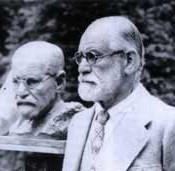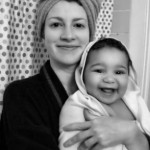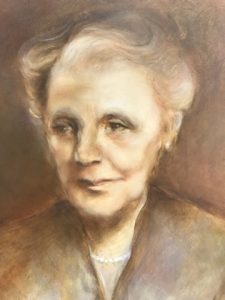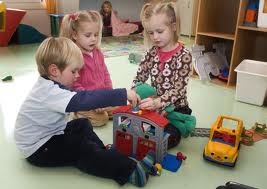To attach, to separate, to internalise and to identify with
To say goodbye, after 28 years, to the psychotherapy training in the region North Holland, invites us to reflect on that which lies behind us and that which is yet to be expected. It is about saying goodbye. Without this, no new perspectives can be opened up, there is no future and neither is there a past. Today, it is about saying goodbye without getting lost, and this not only means to separate, but also to internalise and to identify with.
To train and to be trained
What happens during a training? According to Bion, it is about ‘learning by experience’(1962). During the training, we acquire a new, professional identity. It is about ‘changing’, in thinking, feeling and doing. The whole of mental functioning is involved. During the training, it is about learning to bear what we couldn’t bear before, and to learn how to handle multiple processes, such as identification with and separating from. People identify with new objects en internalise these. They adjust other inner objects or even say goodbye to them. We identify with our teachers, our supervisors and our therapists. We identify with them, but, eventually, we seem to leave them behind, seem to, because, in a special way, we take them with us inside, to make sure we won’t forget them.
 In such processes, we need the other to identify with, we need the ability to make use of the other. Others, on the other hand, also present themselves to identify with and they need to have the ability to be made use of. It is on the basis of such processes that our thinking, feeling and doing start to move and to change. To develop is to separate, to internalise in order to individuate. It is about connecting with others without losing ourselves. It is about being able to be yourself without losing the other. It is about the quality of the interpersonal functioning. This is how we have subscribed it in the new DSM.
In such processes, we need the other to identify with, we need the ability to make use of the other. Others, on the other hand, also present themselves to identify with and they need to have the ability to be made use of. It is on the basis of such processes that our thinking, feeling and doing start to move and to change. To develop is to separate, to internalise in order to individuate. It is about connecting with others without losing ourselves. It is about being able to be yourself without losing the other. It is about the quality of the interpersonal functioning. This is how we have subscribed it in the new DSM.
Separation and mourning
In psychoanalysis, from the beginning it was about separation. Rank already wrote about it in his book about the trauma of birth, which was in fact about the first huge separation in life. We also find the theme in the work of Ferenczi and later Balint. But also the myth of Oedipus is primarily about the separation from the mother object and secondly about the rivalry with father. And this very same theme we find in ‘Totem und Tabu’ (1913), the sons leaving mother and marrying a partner from outside, and so incest was prevented.
However, no separation without mourning. Working through the reality of being separated, working through the absence of the beloved other, in short: working through the anxiety that goes with separation is the beginning of mental functioning. Mental functioning and mourning go together. No goodbye without mourning, this goes for my leaving as head teacher, but also for students saying goodbye to the psychotherapy training. It certainly also goes for our patients, when they end their therapy and say goodbye to their therapist.
 This is the theme of ‘Trauer und Melancholie’(1917). In this, Freud describes the painful process of mourning and the separation of the Self and the Object. In mourning, it is about the realisation that the other has his own life, and is not your possession. That is what it is about in a treatment, but also in a training. In both cases, it is about learning to function autonomously, to know that you are related to the other, but that you are not the other, and that you are a being that has his own life. To mourn means to be able to have a relationship with an object that is not really there. The ability to mourn opens up the ability to symbolise or to build up mental representations.
This is the theme of ‘Trauer und Melancholie’(1917). In this, Freud describes the painful process of mourning and the separation of the Self and the Object. In mourning, it is about the realisation that the other has his own life, and is not your possession. That is what it is about in a treatment, but also in a training. In both cases, it is about learning to function autonomously, to know that you are related to the other, but that you are not the other, and that you are a being that has his own life. To mourn means to be able to have a relationship with an object that is not really there. The ability to mourn opens up the ability to symbolise or to build up mental representations.
Our feeling of having our own identity we get from identification with various people around us. We discover ourselves through the images that look at us from the eyes of others, that meet us. Such images are not replicas of ourselves, but more about the relationship that we have with the one looking at us and that has a place for us in his/her mind. This looking at us may be a loving look, or an unhappy or angry look. We mirror love but also hate, we mirror the relational involvement.
Primary identification
Identification is part of the earliest emotional tie we enter into with the other, wrote Freud in ‘Massenpsychologie und Ich-Analyse’(1921). Our character, he wrote, is partly determined by memory-trails of our earliest identifications. In ‘das Unbehagen in der Kultur’ (1930) Freud introduced what he called the ‘Ozeanisches Gefühl’; such a feeling has to do with a non-solvable relatedness, without limits and with a kind of eternity experience. Without naming this explicitly, he points with this to the early tie between mother and child. It is about the primary identification in which there is not yet differentiation between the Self and the Object/the mother. It is because of this that Winnicott says there is no mother without a child, and no child exists without a mother. It is the baby that is actively seeking the mirroring eyes of the mother, it is the baby that actively provokes the mother to respond further. It is the mother who carries her child emotionally and, by doing this, represents a world that the child “cannot fall out of” (Freud 1930). In terms of Melanie Klein: it is the mother who contains what the child cannot yet contain, because she identifies with her child (Notes on some Schizoid Mechanisms; 1946).

Melanie Klein by Liesbeth Dullaart
 It is important that the child can, in the presence of the other, the mother, still retain his sense of self and, in the absence of the other, retain the sense of the other. Development, thinking and creating mental space is facilitated by the absence of the Object. The concept of primary identification by Freud is similar to the internalising of the mother as surrounding by Winnicott. Internalising has to do with the transformation of external aspects of object relational involvement in inner metal representations. Identification is a special aspect of the process of internalising which is important when building inner mental representations. Identification is related to a specific connection between the Self and the Object. It is a way of protecting the Object. At the same time, the process of identification makes it possible that such things as separation, differentiation, autonomy and enduring loss can come into being. And this also creates more space to be conscious of an independent external reality which we have no control over, but of which we are, in a sense, dependent.
It is important that the child can, in the presence of the other, the mother, still retain his sense of self and, in the absence of the other, retain the sense of the other. Development, thinking and creating mental space is facilitated by the absence of the Object. The concept of primary identification by Freud is similar to the internalising of the mother as surrounding by Winnicott. Internalising has to do with the transformation of external aspects of object relational involvement in inner metal representations. Identification is a special aspect of the process of internalising which is important when building inner mental representations. Identification is related to a specific connection between the Self and the Object. It is a way of protecting the Object. At the same time, the process of identification makes it possible that such things as separation, differentiation, autonomy and enduring loss can come into being. And this also creates more space to be conscious of an independent external reality which we have no control over, but of which we are, in a sense, dependent.
Differentiation of Self and Object
Separation, identification and differentiation help the small child to take the step from the phase José Bleger (1967/2013) calls, in his book ‘Symbiosis and Ambiguity’, the phase of the primitive undifferentiated-ness to the phase of the paranoid schizoid position. This is a step in which the original concurrence of Self and the Other is broken. There begins a certain measure of differentiation between the Self and the Other. In that phase of primitive undifferentiated-ness, symbiosis and autism exist next to each other in narcissistically coloured relational patterns. In that symbiosis, the child puts a part of his Mind into the external world.
 In autism, the movement is pointed inward. Both movements take place within the small child. The Ego is not yet well-defined but more of a deliquescent entity. The ego is still a ‘factual ego’, which means the ego only exists in doing, the action. There is not yet space for interiority and experiencing. The ego is a ‘bodily Ego’. The ego is part of a bigger whole of which it is not yet separated. The primary setting has a symbiotic function, there is concrete behaviour and not yet a symbolising function. There is the need of symbiosis and, at the same time, the need to escape this. The Self is not yet a somatic Self and the Psychological Self is not yet born. The small child will, in the interaction with the primary objects, learn to understand the language of its own body and to understand the meaning of it. Along the way, there will be space for reflection, and behaviour will become less impulsive and more thoughtful. From the phase of being undifferentiated comes the splitting which is characteristic for the paranoid-schizoid position. In short: on the way to differentiation between the Self and the Other.
In autism, the movement is pointed inward. Both movements take place within the small child. The Ego is not yet well-defined but more of a deliquescent entity. The ego is still a ‘factual ego’, which means the ego only exists in doing, the action. There is not yet space for interiority and experiencing. The ego is a ‘bodily Ego’. The ego is part of a bigger whole of which it is not yet separated. The primary setting has a symbiotic function, there is concrete behaviour and not yet a symbolising function. There is the need of symbiosis and, at the same time, the need to escape this. The Self is not yet a somatic Self and the Psychological Self is not yet born. The small child will, in the interaction with the primary objects, learn to understand the language of its own body and to understand the meaning of it. Along the way, there will be space for reflection, and behaviour will become less impulsive and more thoughtful. From the phase of being undifferentiated comes the splitting which is characteristic for the paranoid-schizoid position. In short: on the way to differentiation between the Self and the Other.
Inter-personal functioning: intimacy/relatedness and selfdetermination
In the development, it is about the quality of the inter-personal functioning. The quality of the inter-personal functioning goes hand in hand with the differentiation between the Self and the Other. It is always about alternating between the individual who knows himself to be related with the other and on the other hand a withdrawal in himself. It is about finding a balance between being with the other without losing oneself, and to be with oneself without losing the other. This is what we call to be ‘safely attached’. If the balance shifts to the emphasis on relatedness with the other, the emphasis lies more with the preoccupied attachment, and part of the autonomy is handed in. If the balance shifts to the side of the autonomy, relatedness is handed in and the emphasis is more on autonomy.
Pathology is seen the moment that, because of a failing attachment history, people hand in either the need for autonomy or the need for relatedness. Pathology always has to do with the quality of inter-personal functioning and therefore with the way in which the Self and the Object are differentiated from each other.
1. Pathological maximising of the need for autonomy (Blatt, 2008)
The need for autonomy must be maximised and with that, the need for relatedness must be minimized. Often we see in the history of these patients a failure in the primary objects when it is about their sensitivity, the fact that the child has its own inner world is ignored and with this, the caring objects also fail in their responsiveness.
These people have not learned they can trust their emotions; but they do lean on cognitions. Their affective bandwidth is narrow. In treatment they will do better if the therapy is aimed at offering, in first instance, (cognitive) interpretations.
2. Pathological maximising of the need for relatedness (Blatt 2008)
Here, the need for relatedness must be maximised and, with that, the need for autonomy is minimised. It is about realising the need for fusion, melting. Often we see in the history of these patients a failure of the primary objects to be responsive, which is why, for the child, it is unclear what is his and what is of the primary object. They are, on the other hand, sensitive, in the sense that the primary objects do realise that the child has its own inner world.
We see this in patients, suffering of an anaclytical form of depression, mainly in Borderline, Histrionic and Dependency personality disorders. Research done by Dozier (1999), Slade (2000) and Bakermans – Kranenburg (2009) confirms this. Although, according to Blatt, in the Borderline personality disorder, there are varieties; both the need for autonomy and for relatedness are increased.
These peoples have not learned to trust their cognitions, with them, the emphasis is on the affects. Their affective bandwidth is therefore very wide. In treatment, they will do better if the therapy focusses on the quality of the relationship, in short, is more aimed at offering support instead of offering insight.
Development-oriented treatment
Developing, to find an adequate balance between connecting with the other and to learn to experience oneself as a steering and autonomous agent, this is what it is about within psychoanalytic treatment. It is the treatment session itself in which the change or development takes place. The treatment session is therefore not the place from where we are looking out to how the change is coming about elsewhere. The therapist offers himself as a new primary object, for identification and internalisation. The patient must be able to use the therapist as a new primary object and the therapist must be able to be used as an object for internalisation and identification. The therapist is, to the patient, a new and, hopefully, safer attachment object. In the therapeutic relationship the inner working model (the attachment representation) of the patient (and that of the therapist) is provoked and thereby becomes manifest, in order to be revised. In treatment it is about the primary aspects of the relationship, and about inner conflicts that repeat themselves in the transference.
On the one hand, it is about the curative aspect of the relationship itself, and on the other, it is about the importance of the interpretation. It is about the motherly, but also about the fatherly aspect.
• It is about optimising the mental process and in that, it is about working through the procedurally memorised processes that do not occur consciously. So, this is not about the (dynamic) unconscious but about the not-conscious.
• Next to that, it is about working through conflicting mental representations which have been kept in the dynamic unconscious through the mechanism of repression.
It is important to consider that the unconscious is not something which is stored somewhere in the depths. The unconscious is not something which was previously determined and previously existing in a specific place. Not like photographs, neatly placed into albums, waiting in a cellar until they are taken upstairs. The unconscious generates itself through the development, and in that development the drives are of great importance. To be clear: drives mark the border between the biological and the psychological, it is about mental representation. These are the motor that constitute the unconscious. As we will see later, it is not about two drives, the sexual and the aggressive one, but about ONE drive with two different extremities: relatedness and autonomy.
Blatt says that a psychotherapeutic treatment is like a compacted conglomeration of what happens in the normal development of the individual. In a normal development, people organise their experiences on the basis of the measure that mirrors their need for relatedness or autonomy. People fixate this in cognitive-affective schemas or what we call inner working models. These are procedurally memorised structures, which have to do with the complex interactions between the Self and the Other. These inner working models function as organising principles and interpret and select the experiences people have. This implies that both empathic failure of the surroundings as well as experiences of separations are assimilated in these inner working models. This assimilation of experiences in the inner working model is done through internalising, or we could say the ‘process of internalising of object relational involvements’.
In treatment, it is about revising or adjusting the dysfunctional aspects of these inner working models or introjections. In other words: psychotherapy is a revision workplace to repair dysfunctional aspects of the mental representations that the person has built about himself and the other. It is these mental representations that present themselves within the therapeutic relationship. Psychotherapy is intervening in the cycle of attachment-separation-internalisation. It is about match, mismatch and repairing the mismatch. The revision of the inner working model or the cognitive-affective schemas leads to a more coherent self and a stronger identity. Non-adequate internalisations which limit the functioning are revised and instead, more adequate representations about the Self and the Other have come into being. During this, the therapist functions as a new attachment object. Apart from that, the patient can, in the relationship with his therapist, have new experiences which can further develop the already existing adequate but only partially developed internalisations.
Both patient and therapist bring their own inner working models into the treatment. With this, both are looking for an optimal balance between the need for autonomy and involvement. The working model of both will determine the nature of the therapeutic relationship, and this makes the therapeutic relationship a construction of both patient and therapist. Within the relationship with his therapist, the patient has the chance to experience an alternative inner working model and to test how safe and reliable this new perspective is. Here, too, it is about having a corrective emotional experience with a new and safer attachment object.
An essential part of the treatment is the experience of the patient that he is, just like the therapist, an autonomous person, and with this, he should become conscious to the fact that there is life without the treatment and without the therapist.
 The process of separation is explicitly experienced, this separation process is an essential part of the treatment and it facilitates the process of internalisation. In earlier stages of the treatment, internalising is also an issue, but mainly from the (relative) certainty that the therapist is present. At the end of the treatment this is different: then there is the perspective that patient and therapist will separate at some point. Hopefully, knowing that the patient is able to have an adequate relationship with an object that is no longer present in the reality but which he will take with him in his inner world. The treatment itself is the place in which the change takes place. It is important that the therapist is alert to the fact that what happens within the treatment setting generally also happens in the world outside the treatment. If he doesn’t, and he doesn’t facilitate this enough, then he keeps the patient in what Fonagy calls the ‘pretend mode’ and by doing so he neglects to help the patient grow towards the reflective mode. If that happens, this means the therapist doesn’t have enough regards for the need for autonomy of the patient, next to his need for relatedness. In short: the therapist then fails in adequate sensitivity.
The process of separation is explicitly experienced, this separation process is an essential part of the treatment and it facilitates the process of internalisation. In earlier stages of the treatment, internalising is also an issue, but mainly from the (relative) certainty that the therapist is present. At the end of the treatment this is different: then there is the perspective that patient and therapist will separate at some point. Hopefully, knowing that the patient is able to have an adequate relationship with an object that is no longer present in the reality but which he will take with him in his inner world. The treatment itself is the place in which the change takes place. It is important that the therapist is alert to the fact that what happens within the treatment setting generally also happens in the world outside the treatment. If he doesn’t, and he doesn’t facilitate this enough, then he keeps the patient in what Fonagy calls the ‘pretend mode’ and by doing so he neglects to help the patient grow towards the reflective mode. If that happens, this means the therapist doesn’t have enough regards for the need for autonomy of the patient, next to his need for relatedness. In short: the therapist then fails in adequate sensitivity.
Two drives or one drive with two poles.
Blatt states that, in human functioning, there are always two tendencies observable which occur at the same time, that is the tendency to relatedness and the tendency towards autonomy, or attachment and de-tachment, connecting and dis-connecting. He assumes there are two separate tendencies or drives. Laplanche, however, concludes from his reading of Freud that it is about ONE drive, that is the sexuality, with two different endings.
The drive theory of Freud is bipolar. On the one hand, there is the pole that is about connecting, the fusion (which he calls libido), and on the other hand, there is the pole that concerns dis-connecting, the fragmentation (which he calls the death drive). On the one hand it is about attaching, and on the other about detaching, intimacy and autonomy. In ‘Drei Abhandlungen zur Sexualtheorie’ (1905) Freud defines the drive as a mental concept, on the border of the psychological and the somatic. It is the drive that separates the psychical from the somatic; in spite of this, the somatic is the source of the drive. First, there is a somatic self, and without being able to give words to our emotional experiences, the development towards the psychological self will not take place. It is obvious that the later attachment theories and our present thinking about mentalising and reflective functioning stem from there. In psychoanalysis, it is about ONE drive with two different poles, that is intimacy and on the other hand autonomy and individuality. According to Fonagy, trying to find the right balance between intimacy and individuality is the characteristic of a safe attachment and also the outcome of an adequate containment between the small child and the primary objects.
I have tried to take you, in these 20 minutes with me towards today’s theme. I wish you a wonderful day with many new perspectives about relatedness and autonomy.
Thijs de Wolf
06 06 2014
